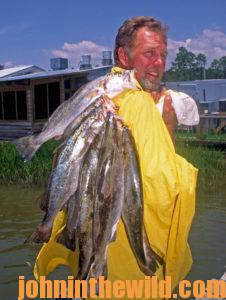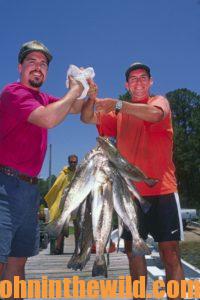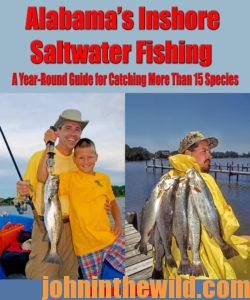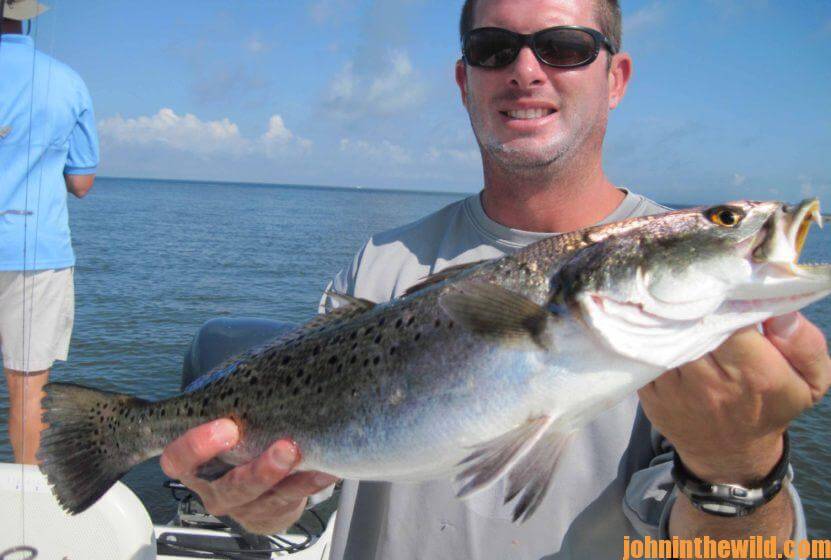Editor’s Note: With many school systems pushing back the start of school in 2020, and with many schools holding virtual classrooms, families are headed to the Gulf of Mexico to enjoy the sand, the water and the fishing. Here are some ideas for productive inshore and offshore fishing.
Speckled trout hold on two types of reefs – public reefs and semi-public reefs. Public reefs consist of manmade reefs, oyster reefs or other types of bottom structure that everyone has pinpointed. The same types of structures that fewer folks know about comprise semi-public reefs. However, even if you choose to fish a semi-public reef in hopes that you’ll have the fish all to yourself, you won’t keep that spot secret for long. Coastal waters have become so heavily fished that few secret fishing spots remain. If you fish a reef near a large concentration of fishermen, the other anglers will see you fishing that reef and learn of its location. If you catch several speckled trout on that reef and anyone sees you, then your secret’s out. Therefore, we need to learn how to fish reefs that  experience only a small amount of fishing pressure as well as reefs that have so many boats on them you can almost step from one boat to the next.
experience only a small amount of fishing pressure as well as reefs that have so many boats on them you can almost step from one boat to the next.
How to Use Fishing Pressure to Your Advantage:
Anglers usually will find the least amount of fishing pressure on any reef during the first hour and a half of daylight. In that magic window of time, few anglers will fish any known trout hot spot. When the sun comes-up, the reef will begin to load up with trout fishermen dropping anchors, talking loudly, throwing fish in the bottom of the boat and spooking every speckled trout around off that reef. That’s when those fishermen won’t catch trout, but you can.
“When those noisy fishermen move on the reef, the trout will move 100-200 yards away from the reef,” says Captain Gary Davis of Magnolia Springs, Alabama, who fishes seven manmade artificial reefs inside Mobile Bay out of Fort Morgan Marina. “When the other fishermen come to the reef, I’ll back away from the reef and look for slicks. The speckled trout and the baitfish will move away from the reefs out into open water. The trout will catch, kill and eat the baitfish, and the oil from the bodies of the baitfish will rise to the surface, creating a slick spot on the water. The school of trout that’s feeding and moving generally will be out in front of the baitfish and anxious to feed.”
To catch these fish, Davis uses grubs, D.O.A. shrimp (https://www.doalures.com/), live shrimp and live croakers. “My favorite bait is the D.O.A. shrimp,” Davis explains. “Because it’s an artificial lure, I don’t have to worry about rebaiting when the trout attack.” Davis casts the D.O.A. shrimp out on 10-pound-test line and lets the shrimp fall to the bottom on a slack line. Because this plastic shrimp has a small piece of lead on the hook in the belly of the shrimp, the lure swims to the bottom just like a live shrimp. Therefore, any action you give the bait detracts from the effectiveness of the lure. According to Davis, “I just watch my line as the shrimp runs with the current, without giving it any action. Then when the trout attacks, the line I use will twitch or jump. That’s my signal to set the hook to catch the trout.”
When Davis or his party gets a big trout on the line, he encourages his fisherman to keep his rod tip in the water, play the trout down and bring the fish slowly to the net. He also tells the lucky angler not to jump up and down and get excited when a big, 4-1/2- to 8-pound trout comes on-board. “I try to keep the fish low in the boat, so that the other anglers on the reef can’t see the size and kind of trout that we’re catching,” Davis emphasizes. “I don’t want to get the fishermen on that public reef to come over and fish the school of trout that I’m fishing because they will usually spook the fish. Then I’ll have to go find another slick to fish.”
How to Slip in on Reefs:
When I fished with another buddy for public-reef speckled trout, he showed me how to slip-in on a reef. “We try to determine which way the wind is blowing, and which way the tide is running before we get to the reef,” my friend says. “Then when we’re about 250-yards away from the reef, we shut-down our big engines and use our trolling motor to position our boat, so that the wind and/or the tide will cause our boats to drift right over the reef. Once we’re 50-100 yards away from the reef, we turn our trolling motor off and let the wind or the current move the boat to within casting distance of the reef. We’re quiet as we approach the reef. We try to disturb the fish as little as possible, while we are over them. We wait until we are about 100-yards away from the reef before we start using either our trolling motor or our big engine to reposition our boat to make another drift over the reef.” Once my friend drifts to 100-yards below the reef, he uses his trolling motor to go another 100-yards below the reef, cranks-up his big engine and makes a wide semi-circle, staying at least 200-yards away from the reef. Then he repositions his boat as he has earlier to drift the reef once more.
How to Fish With the Birds:
When fishing pressure builds-up on reefs that hold speckled trout, the shrimp and the baitfish will move-out away from the reef and swim in open water. When the trout that swim below a school of baitfish start attacking the bait, the bait will move almost to the surface of the water. If a passing seagull sees that bait, it immediately dives on and feeds on the bait near the surface. Once other se agulls observe a gull diving, they immediately flock to that school of bait and also start diving on the bait.
agulls observe a gull diving, they immediately flock to that school of bait and also start diving on the bait.
“When we spot birds working like this, we use the same wind-drift or tide-drift technique to let our boats move to within casting distance of the diving birds,” says yet another fishing buddy. “People often don’t catch trout under diving birds, because they become so excited when they see birds working that they run full throttle straight toward the birds and get in too close before they shut down their big engines. However, I remain as far away as possible from the birds and their bait and still make accurate casts. If you don’t spook the bait and the birds, you often can limit-out on trout under one flock of birds. But what often happens is that another angler will see the birds, move-in too close and spook the birds and the bait while you’re trying to fish them. Still, fishing birds and slicks are two great techniques to use anywhere in salt water when fishing pressure builds-up on reefs and causes trout to move off the reefs.”
How to Use the Popcorn Trick:
To catch speckled trout in intensely-fished areas, you have to out-fish the other anglers as well as fool the trout. I’ve seen guides use a technique called the popcorn trick to fool the fish. When they see a slick or a flock of birds appearing and baitfish flipping on the surface, they often will sprinkle popcorn 200-300 yards away from the spot where the trout are feeding. When the gulls spot the popcorn on the surface of the water, they immediately will begin to dive on that popcorn and appear to feed on baitfish. Once other anglers see the birds diving, they’ll go close to the birds and begin fishing what they believe to be a school of trout. While the other anglers fish the popcorn, the person who’s put-out the popcorn can fish, undisturbed, the school of trout he’s found. I don’t suggest or recommend that you put out popcorn to cause gulls to start working. However, I have seen it done. Plenty of speckled trout congregate on public reefs, but unless you know what the trout do and where they go when the fishing pressure builds-up on those reefs, you rarely, if ever, will catch those trout. However, if you use these tactics of some of the best trout fishermen I know, you will locate and take the trout that the other fishermen never see or find.
trick to fool the fish. When they see a slick or a flock of birds appearing and baitfish flipping on the surface, they often will sprinkle popcorn 200-300 yards away from the spot where the trout are feeding. When the gulls spot the popcorn on the surface of the water, they immediately will begin to dive on that popcorn and appear to feed on baitfish. Once other anglers see the birds diving, they’ll go close to the birds and begin fishing what they believe to be a school of trout. While the other anglers fish the popcorn, the person who’s put-out the popcorn can fish, undisturbed, the school of trout he’s found. I don’t suggest or recommend that you put out popcorn to cause gulls to start working. However, I have seen it done. Plenty of speckled trout congregate on public reefs, but unless you know what the trout do and where they go when the fishing pressure builds-up on those reefs, you rarely, if ever, will catch those trout. However, if you use these tactics of some of the best trout fishermen I know, you will locate and take the trout that the other fishermen never see or find.
To learn more about saltwater fishing, check out John E. Phillips’ book, “Alabama’s Inshore Saltwater Fishing: A Year-Round Guide for Catching More Than 15 Species” at http://amzn.to/11dJhN7. If necessary, copy and paste the link into your browser.
Tomorrow: Use These Summertime Tactics to Troll the Gulf of Mexico Near Shore
















